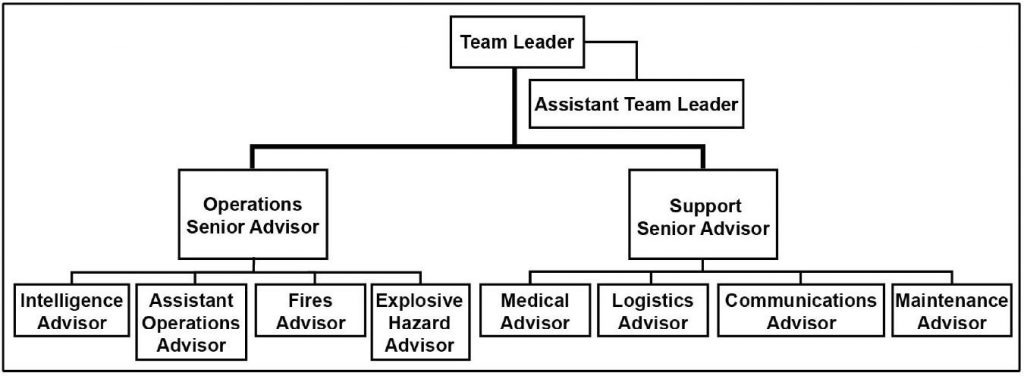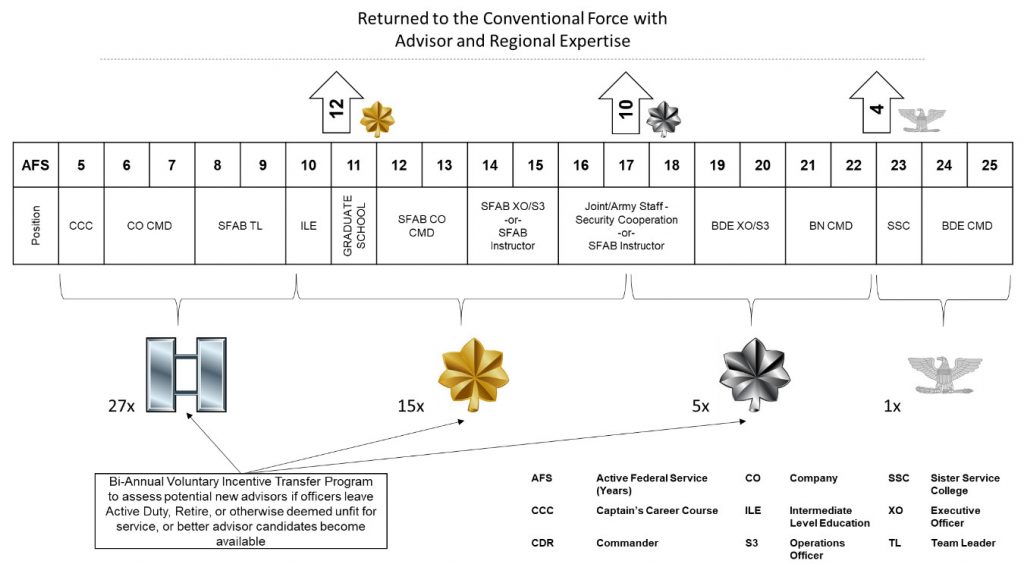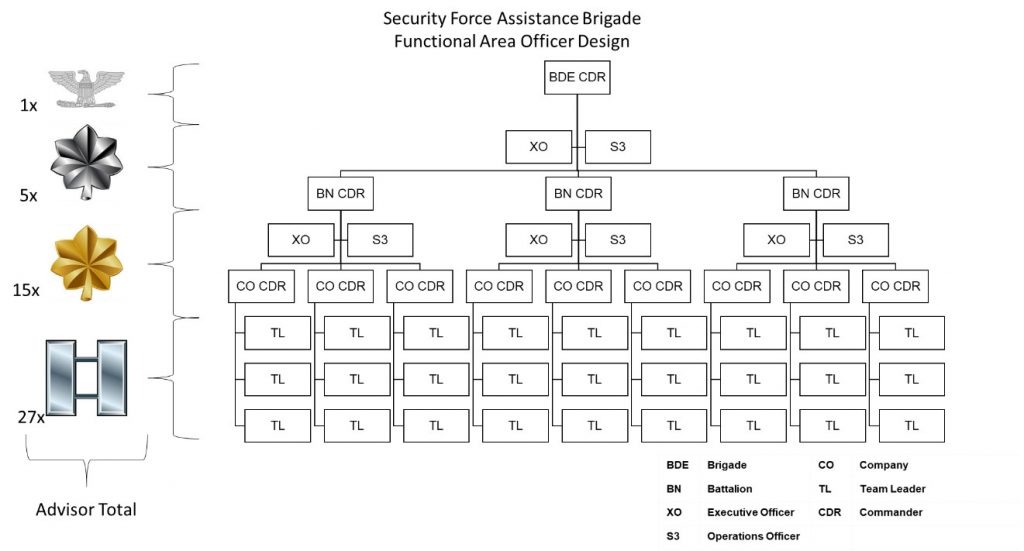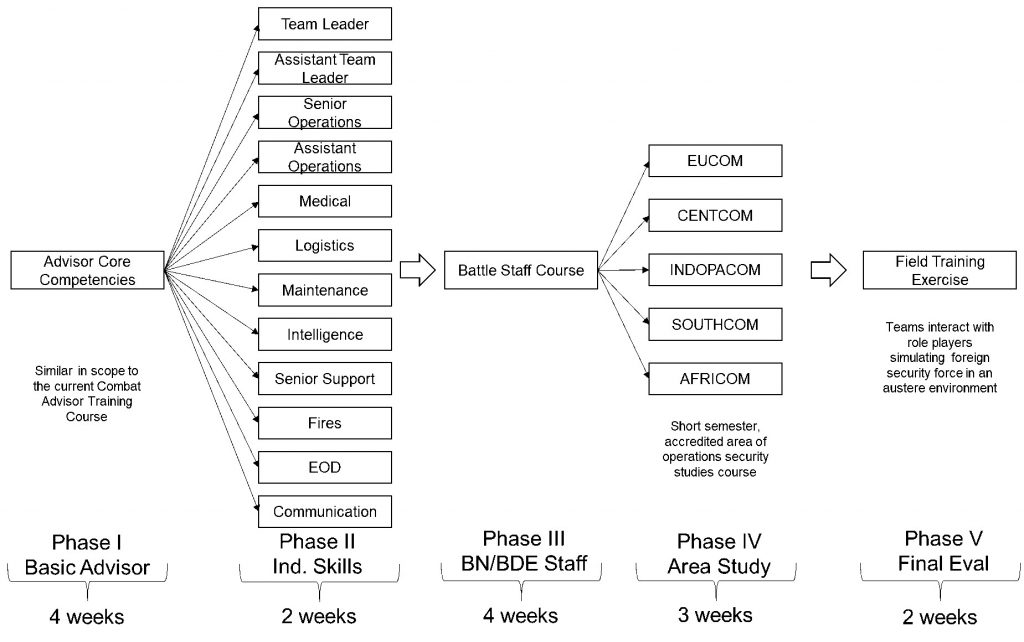During planning for what became Operation Uphold Democracy in Haiti in 1994, a prescient conversation occurred between planners from United States Atlantic Command and members of the Department of Justice. Despite establishing the International Criminal Investigative Training Assistance Program under the Department of Justice to train a new Haitian police force, when told of how the political-military plan envisioned the department's execution of the operation, the Justice representative stated that the department "
could not handle the mission." At the last minute, an Army infantry battalion was handed the responsibility to train, advise, and assist a newly created Haitian police force. This foreshadowed what would become the standard during America's post-9/11 wars in Iraq and Afghanistan-infantry and other combat arms units converted to advisors in an ad hoc fashion.
That would begin to change with the US Army's new security force assistance brigades (SFABs), which are designed to provide conventional force training, advice, and assistance to foreign security forces. To that end, SFAB advisors are formed into twelve-soldier teams, designed to parallel the skills of a battalion and higher staff, with specialists in combat operations and support functions. This diverse team is designed to survive on its own, working in full partnership with a foreign battalion or brigade's leadership dispersed throughout the battlefield without US support while providing critical linkage back to the joint force for partner-nation battle tracking, combat employment, allocation of supporting artillery and aircraft. The team also conducts assessments of the partner force's capability to adjust US policy goals in the region.

Besides enhancing foreign internal defense lines of efforts and enabling the US military to establish new foreign security forces, SFABs reduce the burden on brigade combat teams, which are poorly organized for advisor missions. SFABs have deployed to Afghanistan and Iraq, but their role in other regions-including the areas of responsibility of
Africa Command and
Southern Command-is set to expand. Despite this new focus outside of advising missions solely in Afghanistan and Iraq, the Army's assignment and training process for advisors has no regional focus and loses trained advisors after a short utilization period.
The advisor team fills an important capability gap, allowing US conventional forces to concentrate solely on readiness, deterrence, and ultimately combat operations. It preserves the officer and senior noncommissioned officer ranks in these units by not pulling them away to train local nationals as has often happened in Iraq and Afghanistan. Given the importance of this mission, the Army should consider professionalizing this cadre of advisors by developing a functional area assignment for advising that would increase assignment longevity and advisor skills instead of the form it currently takes, as a broadening assignment of less than three operational years.
In the current assignments process, those interested in becoming advisors undergo a hiring process-for noncommissioned officers, a
three-day assessment at Fort Bragg, North Carolina, and for officers, interviews with the brigade and battalion commanders under whom they would serve if selected. Following selection, prospective advisors all attend a four-week Combat Advisor Training Course, taught at the
Military Advisor Training Academy, located at Fort Benning, Georgia. This course teaches each cohort, the members of which range from specialists (E-4) to lieutenant colonel (O-5), collectively-which is an exceedingly wide array of skill levels and years of professional service. Following graduation, each advisor is assigned an
additional skill identifier that marks them as advisor qualified.
The Combat Advisor Training Course offers only a
rudimentary advising curriculum. Given the large breadth of ranks needing to be trained in the four weeks, training is limited to blocks of instruction on employing an interpreter, cross-cultural awareness, and conducting training assessments, while tactical instruction focuses on survivability skills like medical treatment, employment of indirect fire assets, and land navigation. The Army is able to mitigate the risk of this short, mile-wide-but-inch-deep certification because the majority of those assigned have had multiple deployments in their careers, with most having at least some experience in either training or advising Iraqi or Afghan counterparts in the past. As operations
wind down in Afghanistan and Iraq, this reliance on previous experience in advising foreign security forces will evaporate quickly.
Rather than relying on a brief, four-week course in order to maximize utilization during a broadening assignment, the Army should consider making advisor positions a
functional area for officers. Rather than returning to the regular assignments process following their three-year assignment, functional area officers are retained and progress within that functional designation. This change, and an accompanying advisor secondary military occupational specialty for enlisted personnel, would allow the Army to maintain a competent core of advisors without impacting their promotion potential and career progression.
Given that advisors are required to interact on a regular basis with members of a foreign security force, it would make sense for them to be assigned and developed according to DoD policy on the management of the
Defense Language, Regional Expertise, and Culture Program. That program includes a description of various levels of regional proficiency. If the Army adopts a functional area model for advisors-in tandem with
plans to align each SFAB with a geographic combatant command-there is significant potential for the development of a cadre of advisors that are regionally proficient at level 2 (Associate) and level 3 (Professional) by the time they reach senior field-grade assignments (See figure below). As it stands right now, there is no regional proficiency selection or assignment process for an SFAB broadening assignment, meaning officers and noncommissioned officers at regional proficiency level 0 (Pre-Novice), with essentially no experience or formal education in the region at all, are assigned as advisors.

In this functional area model for officers, the selection process would select from pools of captains following their time in a key developmental position. While the figure below only focuses on combat arms advisors whose key developmental position is company command, a similar process would be made for operational support positions. Each brigade would have twenty-seven combat advisor teams led by a functional area advisor. As cohorts of officers progress through the ranks, the majority would be returned to their original branch or leave the service through normal attrition, while high performers with an aptitude for advising would assume positions of greater authority. This accomplishes two major objectives. First, it returns to the brigade combat team a cohort of officers with regional experience that will be invaluable in future crisis response planning and execution. Second, and more importantly, it provides a retention capability for the advisor corps, in a specific regional specialty, similar to the foreign area officer corps. As advisors progress, they would be able to complete advanced schooling in regional and international affairs that would professionalize the corps over time. Supplemental positions not of an advising nature, like a company executive officer, can remain part of the regular assignments process.

Functional area advisor model for officer career progression.

SFAB advisor team leadership hierarchy under functional area model.
The functional area assignments process allows advisors to become regionally focused and deploy to the same area of operations over the course of their career. This would enable officers to understand the human terrain of the area, develop military-to-military relationships at the tactical level, and build on previous successes. An SFAB, fielded with functional area advisors, regionally aligned to AFRICOM, for example, could send the same cohorts of officers to advise training and operations in the Sahel consistently, with advisors and foreign security partners working together as they progress through the ranks.
The figure below is based on the Army's old
Army Force Generation model, but it could be applied to SFABs with regional alignment. Doing so would allow a three-battalion SFAB to maintain one battalion and its twenty-seven advisor teams deployed to a region, one battalion conducting reset, and one battalion in a trained and ready phase, capable of surging support in times of crisis. With five regionally aligned active duty brigades, SFABs would have a persistent forward presence. The Army's National Guard SFAB, rather than an independently deployable brigade, would be an auxiliary and reserve force from which each brigade would be able to request augmented support if the manpower requirement becomes onerous for any particular region or a crisis erupts. Rather than a whole brigade focused on the region, the National Guard SFAB would develop advisor teams and individuals that were regionally focused; operating more as a strategic reserve than an operational force.

Possible regionally aligned SFAB structure.
While a functional area assignments process would impact the SFABs' officer corps, special assignment procedures for noncommissioned officers with a secondary military occupational specialty would allow for enlisted personnel to progress as advisors without negatively impacting their promotion potential. Because the current assignments process is a broadening assignment, much like their officer counterparts, enlisted personnel are returned to the conventional force in order to fill key developmental positions for their rank and primary specialty and be promotable. As a secondary specialty, advisors would attend specific geographic combatant command and advisor training. Additionally, a fully accredited
battle staff course component will likely be necessary to give noncommissioned officers greater exposure staff functions for their specialty at the battalion level and above. Incorporating a battle staff course into the training pipeline ensures that all members of the advising team are capable of understanding and advising planning at echelons above their previous competency.

Potential advisor qualification pipeline in a functional area/secondary military occupational specialty system.
This proposal-adopting functional area and secondary military occupational specialty assignments-would require significant investment. It would also need buy-in from geographic combatant commanders. Each commander would need to see the value in having a reliable pool of well-trained advisors. Without this, and funding allocated by Congress, it would be moot to develop advising as a functional area. If combatant commanders do see the value,
as seems to
be the case, SFABs would provide a real advise-and-assist capability, rather than training or advising forces in an ad hoc manner with brigade combat teams or with advisors with limited cultural or staff knowledge. Combatant commanders would be able to call on a contingent of regionally astute and tactically capable advisors to deploy to the same area of operations repeatedly, reducing the time required to achieve foreign security force goals.
The proposed change in assignments process offers four distinct advantages. First, it increases the Army's ability to meet international security cooperation agreements at a significantly reduced cost in dollars and readiness. Train-and-advise missions can be accomplished with relatively fewer individuals and a smaller equipment package, and a constant development pathway extends beyond a single brigade rotation to a theater. It also alleviates the need to deploy brigade combat teams, thereby increasing operational readiness by maintaining more brigades available for decisive-action deployments if required.
Second, it enhances partnerships in an era when the Army no longer goes to war alone. The
National Defense Strategy specifically describes strengthening alliances and attracting new partners as a strategic priority, and redesigning the SFAB assignments process directly impacts this priority. Besides the enhanced security cooperation that would be accomplished with more regionally attuned advisors, during decisive-action operations with a combined force the SFABs could prove invaluable. Rather than having to give up staff horsepower to serve as liaison officers during a crisis, the Army could now provide advisor teams that have habitual training and advising relationships with countries contributing to the coalition at all echelons. The wide array of talent provided by the advisor team can impact everything from coalition communication to intelligence dissemination to indirect fire and close air support.
Interoperability is always a challenge in these environments; advisor teams, self-contained and backed by significant communications capability, can tie into every staff function of a coalition partner or ally to synchronize operations.
Third, the new assignments process allows for the retention of combat arms and support personnel outside of the current brigade combat team structure. By retaining mid-career officers and noncommissioned officers, the Army has the ability to rapidly expand and increase the number of its brigade combat teams in short order. Essentially, SFABs can rapidly absorb newly recruited personnel to become full brigade combat teams as the majority of key leadership positions are already filled. Each SFAB battalion essentially has almost a full brigade's complement of combat arms officers. While this has been touted as a feature virtually
since SFABs were first proposed, the current broadening assignment model creates limitations. In order to create the numerous post-key developmental positions the SFABs require, and do so continuously, key developmental position length is curtailed in order to meet the demand. Instead, by offering a functional area to grow and retain officers, the Army will no longer have to rapidly certify officers as having completed their time in key developmental positions to be available for SFABs. This stabilization in a functional area enables greater training time available by reducing the numbers of permanent changes of station.
Finally, it increases the Army's regional competency. While this commentary has focused solely on the advisor assignments process and the retention of trained personnel, it also redistributes back to the force officers and enlisted personnel with an increased regional proficiency that have a better understanding of allies and partners. This assignments process would return twelve captains from each brigade to the conventional force after their team leader time. Having been exposed to regional tactics, techniques, and procedures, completed advisor rotations to foreign countries, and developed an enhanced understanding of planning at battalion and brigade level, this assignments process pays huge dividends to the conventional force, as well.
Because the SFABs are still being constituted, treating them as broadening assignments makes sense for the time being. These organizations have a proven requirement to meet national objectives and need to be utilized, so there is a need to rapidly fill their ranks. However, the functional area and secondary specialty assignments process described above should be instituted over the coming years as advisory experience from years of deployments to Afghanistan and Iraq increasingly evaporates from the force. If the Army wants to transition the SFAB from an organization that-outside of longer deployments in Afghanistan and Iraq-merely provides short-duration training packages like a
three-week vehicle-recovery course for foreign partners into a true cadre of combat and sustainment advisors that have a persistent foreign presence, it needs to radically rethink the assignments and education process for the position. After years of deployments to Iraq and Afghanistan, the Army recognizes that there is a mission requirement to have an advisor corps. Establishing the SFABs is an important first step. The next one should be a fundamental reassessment of its assignment, education, and fielding model.
Jon Tishman is a captain in the US Army currently assigned as an advisor team leader with 4th Security Force Assistance Brigade. Jon has deployed four times to Iraq and Afghanistan. During a break in service Jon lived in Australia selling military equipment to foreign militaries in the Australasia region. He commissioned from the Virginia Military Institute and is pursuing a master's degree in international relations.
The views expressed are those of the author and do not reflect the official position of the United States Military Academy, Department of the Army, or Department of Defense.